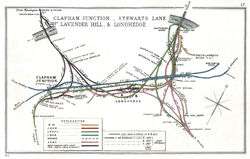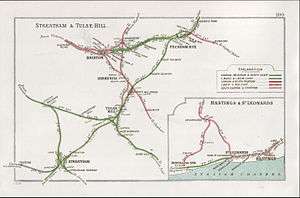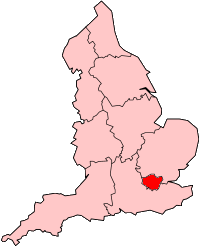South London Line
| South London Line | |
|---|---|
|
A London Overground train at Clapham High Street | |
| Overview | |
| Type | Commuter rail, Freight rail |
| System | National Rail |
| Status | Operational |
| Locale | Greater London |
| Termini |
London Victoria London Bridge |
| Stations | 10 |
| Operation | |
| Owner | Network Rail |
| Operator(s) |
London Overground Southern Southeastern |
| Rolling stock |
Class 378 "Capitalstar" Class 465 "Networker" Class 466 "Networker" |
| Technical | |
| Track gauge | Standard gauge |
| Electrification | 750 V DC third rail |
| South London Line | |||||||||||||||||||||||||||||||||||||||||||||||||||||||||||||||||||||||||||||||||||||||||||||||||||||||||||||||||||||||||||||||||||||||||||||||||||||||||||||||||||||||||||||||||||||||||||||||||||||||||||||||||||||||||||||||||||||||||||||||||||||||||||||||||||||||||||||||||||||||||||||||||||||||||||||||||||||||||||||||||||||||||||||||||||||||||||||||||||||||||||||||||||||||||||||||||||
|---|---|---|---|---|---|---|---|---|---|---|---|---|---|---|---|---|---|---|---|---|---|---|---|---|---|---|---|---|---|---|---|---|---|---|---|---|---|---|---|---|---|---|---|---|---|---|---|---|---|---|---|---|---|---|---|---|---|---|---|---|---|---|---|---|---|---|---|---|---|---|---|---|---|---|---|---|---|---|---|---|---|---|---|---|---|---|---|---|---|---|---|---|---|---|---|---|---|---|---|---|---|---|---|---|---|---|---|---|---|---|---|---|---|---|---|---|---|---|---|---|---|---|---|---|---|---|---|---|---|---|---|---|---|---|---|---|---|---|---|---|---|---|---|---|---|---|---|---|---|---|---|---|---|---|---|---|---|---|---|---|---|---|---|---|---|---|---|---|---|---|---|---|---|---|---|---|---|---|---|---|---|---|---|---|---|---|---|---|---|---|---|---|---|---|---|---|---|---|---|---|---|---|---|---|---|---|---|---|---|---|---|---|---|---|---|---|---|---|---|---|---|---|---|---|---|---|---|---|---|---|---|---|---|---|---|---|---|---|---|---|---|---|---|---|---|---|---|---|---|---|---|---|---|---|---|---|---|---|---|---|---|---|---|---|---|---|---|---|---|---|---|---|---|---|---|---|---|---|---|---|---|---|---|---|---|---|---|---|---|---|---|---|---|---|---|---|---|---|---|---|---|---|---|---|---|---|---|---|---|---|---|---|---|---|---|---|---|---|---|---|---|---|---|---|---|---|---|---|---|---|---|---|---|---|---|---|---|---|---|---|---|---|---|---|---|---|---|---|---|---|---|---|---|---|---|---|---|---|---|---|---|---|---|---|---|---|---|---|---|---|---|---|---|---|---|---|---|---|---|---|---|---|---|---|---|---|---|
Legend | |||||||||||||||||||||||||||||||||||||||||||||||||||||||||||||||||||||||||||||||||||||||||||||||||||||||||||||||||||||||||||||||||||||||||||||||||||||||||||||||||||||||||||||||||||||||||||||||||||||||||||||||||||||||||||||||||||||||||||||||||||||||||||||||||||||||||||||||||||||||||||||||||||||||||||||||||||||||||||||||||||||||||||||||||||||||||||||||||||||||||||||||||||||||||||||||||||
| |||||||||||||||||||||||||||||||||||||||||||||||||||||||||||||||||||||||||||||||||||||||||||||||||||||||||||||||||||||||||||||||||||||||||||||||||||||||||||||||||||||||||||||||||||||||||||||||||||||||||||||||||||||||||||||||||||||||||||||||||||||||||||||||||||||||||||||||||||||||||||||||||||||||||||||||||||||||||||||||||||||||||||||||||||||||||||||||||||||||||||||||||||||||||||||||||||
The South London Line is an 8.5-mile (13.7 km) horseshoe-shaped Inner London railway from Victoria to London Bridge via Peckham Rye.
The line is in Travelcard Zone 2 apart from the termini, in Zone 1.
Until December 2012, Southern operated a half-hourly passenger service between London Bridge and Victoria.
As part of the project to create an orbital railway around London, most of the South London Line was incorporated into the London Overground network.[1] The Southern service ceased on 9 December 2012 and westbound services were diverted from Victoria to Clapham Junction, while eastbound trains now join the East London Line instead of terminating at London Bridge.[2][3] Services travelling north from East Dulwich continue to use the eastern portion of the line from Peckham Rye to London Bridge.
A short section of the line between Wandsworth Road and Clapham High Street was used by Eurostar when trains ran from London Waterloo International. As they have had their third rail shoes removed in 2007, they can no longer run on this line. Eurostar trains now run into and out of the new terminus at St Pancras International via the Channel Tunnel Rail Link, which opened in 2007.
History
The London, Chatham and Dover Railway (LCDR) was authorised to build the line by the South London Railway Act 1862. Designed and engineered under Frederick Banister,[4] it re-used the Wandsworth Road to Brixton section built as part of the LCDR main line. This line was quadrupled and extended to London Bridge. The northern pair (now the Chatham lines), with no stations, was used by the LCDR; the southern (now the Atlantic lines) was used by the London, Brighton and South Coast Railway (LBSCR). Several stations were shared by the two companies.
The LBSCR scheme, authorised in 1903, pioneered main-line rail electrification in the UK, and the first electric train ran on 1 December 1909. For the following three years, steam trains alternated with electrics, the latter operating a 15-minute interval service from 7.30am to midnight. Passenger numbers had falling dramatically following the opening of electric tramways in South London - by 1.25 million in only six months - but in the first year of electric operation, passengers almost doubled, from 4 million to 7.5 million. The electrification used the overhead system at 6700 V AC, supplied by a power station at Deptford. The line was converted to Southern Railway standard third-rail 660 V DC on 17 June 1928.
East London Line extension

In 2012 a 2.5-kilometre (1.6 mi) diversion was made at the eastern end, connecting it to the East London Line, a former London Underground line which was reconverted to main line operation as part of phase 2 of the East London line extension project. The diversion used an alignment between Rotherhithe and Peckham that had been disused since 1911, via Old Kent Road station. The link allows trains to run from Surrey Quays to Clapham Junction via Queens Road Peckham, Peckham Rye, Denmark Hill, Clapham High Street and Wandsworth Road. Completion was originally scheduled for May 2012 in time for the London 2012 Summer Olympic and Paralympic Games,[5][6] but the actual opening date was 9 December 2012.[7]
The East London line connects to the North London line at Highbury & Islington, completing an orbital rail route around Central London, fulfilling the Orbirail concept.
The South Cross Route, one side of the London Motorway Box, the innermost ring road of the unbuilt 1960s London Ringways plan, would have paralleled the line between Wandsworth Road and Peckham Rye.
Services
Passenger rail services were provided by Southern, as are the continuing services on the eastern section from Peckham Rye to London Bridge.
Services along part of the line are operated by Southeastern on the Victoria-Dartford and the Chatham Main Lines, calling only at Denmark Hill and Peckham Rye.
Off-peak services were typically two trains per hour from smaller stations such as Clapham High Street, with four trains per hour from Denmark Hill.
However Southern now only operates a limited service from Kensington Olympia to Wandsworth Road.
From December 2012
Due to the Southern service between London Victoria and London Bridge being axed, there were some reductions to services for passengers who used the services in the area. There was no service to London Victoria for passengers at Denmark Hill and Peckham Rye during Mon-Fri evenings & Sundays.
Denmark Hill & Peckham Rye Off-peak & Saturday
- 4tph between Clapham Junction & Highbury Islington (London Overground)
- 2tph between London Victoria & Dartford via Bexleyheath (Southeastern)
Evenings:
- 4tph between Clapham Junction & Highbury Islington (London Overground)
Sundays:
- 4tph between Clapham Junction & Highbury Islington (London Overground)
From January 2015
Due to the Thameslink Programme causing Southeastern to make modifications to its timetable, it has been proposed that the following service pattern will operate.[8]
Off-peak & Saturday
- 4tph between Clapham Junction & Highbury Islington (London Overground)
- 2tph between London Victoria & Dartford via Bexleyheath (Southeastern)
- 1tph between London Victoria & Dover Priory via Chatham (Stopping at Denmark Hill Only - Southeastern)
Evenings:
- 4tph between Clapham Junction & Highbury Islington (London Overground)
- 2tph between London Victoria & Dartford (Southeastern)
- 1tph between London Victoria & Dover Priory via Chatham (Stopping at Denmark Hill Only - Southeastern)
Sundays:
- 4tph between Clapham Junction & Highbury Islington (London Overground)
- 2tph between London Victoria & Dartford (Southeastern)
- 1tph between London Victoria & Dover Priory via Chatham (Stopping at Denmark Hill Only - Southeastern)
Future developments
During the extension of the East London Line, it was proposed in 2001 to add a station at Surrey Canal Road.[9] A campaign group was formed in 2009 by Bermondsey residents to press for funding to be made available.[10][11] In September 2010, the £7 million funding for this was refused by the Department for Transport.[12] The property developer Renewal has since agreed to fund construction as part of its Surrey Canal development scheme and Lewisham Council has granted planning permission.[13] During a presentation at the site as part of the Open House 2014 weekend, it was revealed that the station would not be called Surrey Canal Road and that Renewal were working in partnership with TfL to confirm the rebrand of the area, the name of which will be used by the station and as the name for a whole new district of London. In 2015, TfL announced that the area of major development surrounding the station would be named "New Bermondsey".[14] Construction work is likely to start before the end of 2015.[15]
Proposed developments
Victoria to Bellingham service

One of the disadvantages of incorporating the line into the London Overground network was the loss of services to Victoria and London Bridge.[2] Some passengers must now change at Clapham Junction or one of the Peckham stations to reach the central termini. They have expressed dissatisfaction at this change and mounted public campaigns to retain these services.[16][17] A survey by London Travelwatch found that 88% of passengers on the line felt they would be inconvenienced by the changes (although the survey also noted that respondents were generally unaware of the ELL/Overground proposals or of any possible benefits they might bring).[18]
To compensate for the loss of services, it was proposed to introduce a Victoria-Bellingham service along the line as far as Peckham Rye, branching off onto the Catford Loop Line to Bellingham. The proposal was abandoned due to funding issues but appears to have been resurrected (as of March 2010) after lobbying by various pressure groups and local MPs.[19]
The original decision (since resurrected after pressure groups and local MPs urged the Mayor to reconsider and secured funding from the Secretary of State for Transport) to abandon the Victoria to Bellingham proposal has also been criticised. Transport for London was the subject of critical commentary for the decision — especially as it had diverted funding for the Bellingham proposal to support construction work on the London Overground extension project — and for publicly attributing this decision to the Department for Transport.[19][20]
Following consultation with London Travelwatch, TfL compiled a shortlist of possible solutions to address the concerns of transport campaigners. The options include various combinations of additional stops for fast trains, increased service frequencies, and the Victoria-Bellingham route. The list of options is being considered by TfL, Network Rail and the DfT, and a decision will be announced in May 2010.[2]
Other additional stations
Between Denmark Hill and Clapham High Street, the line passes through Brixton, crossing over Loughborough Junction and Brixton stations but without its own stations.[21] In 2004, concerns were raised by local politicians and residents that the Brixton area was not being served by the line and campaigners criticised the East London Line Extension project for missing opportunities to create interchange stations with Thameslink and the London Underground Victoria line.[22][23][24]
No stations were planned at these locations as the line is on high viaducts, increasing the costs of station construction prohibitively.[25] The Mayor of London, Ken Livingstone, expressed doubts that any proposals to construct these stations would pass a cost-benefit analysis and that they would be unlikely to be approved.[22] Lambeth Council and the East London Line Group have expressed support for an interchange station at Brixton and have requested that this proposal be considered for future funding.[26][27] Suggestions have been made that the East Brixton could be re-opened as an alternative.[28]
See also
References
- ↑ "Clapham Junction to Surrey Quays". Transport for London. Retrieved 6 November 2012.
- 1 2 3 "London Overground: South London Line". Transport for London. Retrieved 28 May 2010.
- ↑ "Outer London rail orbital opens for passengers". BBC News. Retrieved 14 December 2012.
- ↑ "Federick Dale Banister". GracesGuide.co.uk. Retrieved 10 February 2013.
- ↑ "London rail link gets green light". BBC News. 12 February 2009. Retrieved 16 February 2009.
- ↑ Cahalan, Paul (12 February 2009). "Approval for £75m rail plan linking Clapham Junction to Docklands in 20 minutes". Wandsworth Guardian. Retrieved 14 December 2012.
- ↑ "London Overground Clapham Junction to Surrey Quays". Transport for London. n.d. Retrieved 4 July 2012.
- ↑ "January 2015 Draft Timetable" (Press release). Southeastern Railways. 2 July 2014. Retrieved 28 July 2014.
- ↑ "Tube line extensions 'approved'". BBC News. 9 October 2001. Retrieved 17 December 2012.
- ↑ "Surrey Canal Road Station campaign". Archived from the original on 14 June 2010. Retrieved 17 December 2012.
- ↑ "NEW CROSS: Agreement on Surrey Canal Road station draws closer". This Is Local London. 27 November 2009. Retrieved 17 December 2012.
- ↑ "Surrey Canal Road station campaign must continue says Caroline Pidgeon". Rail News. 2 September 2010. Retrieved 17 December 2012.
- ↑ "Surrey Canal Road station". Lewisham Council website. Retrieved 17 December 2012.
- ↑ London Housing Zones https://www.london.gov.uk/sites/default/files/Housing%20Zones%20-%20The%20First%20Nine%20Zones.pdf
- ↑ New Bermondsey http://www.newbermondsey.com/transport
- ↑ "Demonstrators 'mourn' loss of South London Line service". BBC News. Retrieved 14 December 2012.
- ↑ "Stop the rail cuts campaign". Southwark Rail Users' Group. Retrieved 18 October 2009.
- ↑ The Railway Consultancy Ltd. "South London Line Research Study". London TravelWatch. Archived from the original on 28 July 2011. Retrieved 31 October 2009.
- 1 2 "Boris slammed on South London Line". South London Press. 12 October 2009. Retrieved 18 October 2009.
- ↑ "The Price of ELL Phase 2: Victoria-Bellingham Cancelled". London Reconnections (blog). 23 April 2009. Retrieved 31 October 2009.
- ↑ Transport for London (2006). "The Tube in 2010". Retrieved 3 November 2007. (map illustrating future development phases as proposed by TfL in 2006, subject to change)
- 1 2 Shawcross, Val (17 November 2004). "Mayor answers to London - Loughborough Junction and Brixton Stations". London Assembly. Retrieved 22 December 2012.
- ↑ "Junction joy South". South London Press. Streatham. 24 April 2004. Archived from the original on 9 May 2004. Retrieved 3 November 2007.
- ↑ Linton, Martin, MP (19 July 2006). "Parliamentary Debate: London Orbital Rail Network". Hansard (House of Commons). UK Parliament. Retrieved 3 November 2007.
- ↑ "East London Line Extensions - Loughborough Junction". AlwaysTouchOut. 9 November 2006. Retrieved 3 November 2007.
- ↑ "ELLG response to the South London Route Utilisation Strategy" (PDF). Network Rail. 26 October 2007. Retrieved 19 December 2012.
- ↑ "East London Line extension". Public transport consultation. Lambeth Borough Council.
- ↑ "Then and Now: East Brixton station". Urban75. Retrieved 18 October 2009.
External links
| Wikimedia Commons has media related to South London Line. |
- South London Press article: 'Boris slammed on South London Line'
- South London Press article: 'Bid to save the South London Line'
- "'The South London Line And Its Traffic'" (PDF). (1.03 MiB) - a reproduction of a September 1953 article from The Railway Magazine, courtesy of the Southern E-mail Group.





